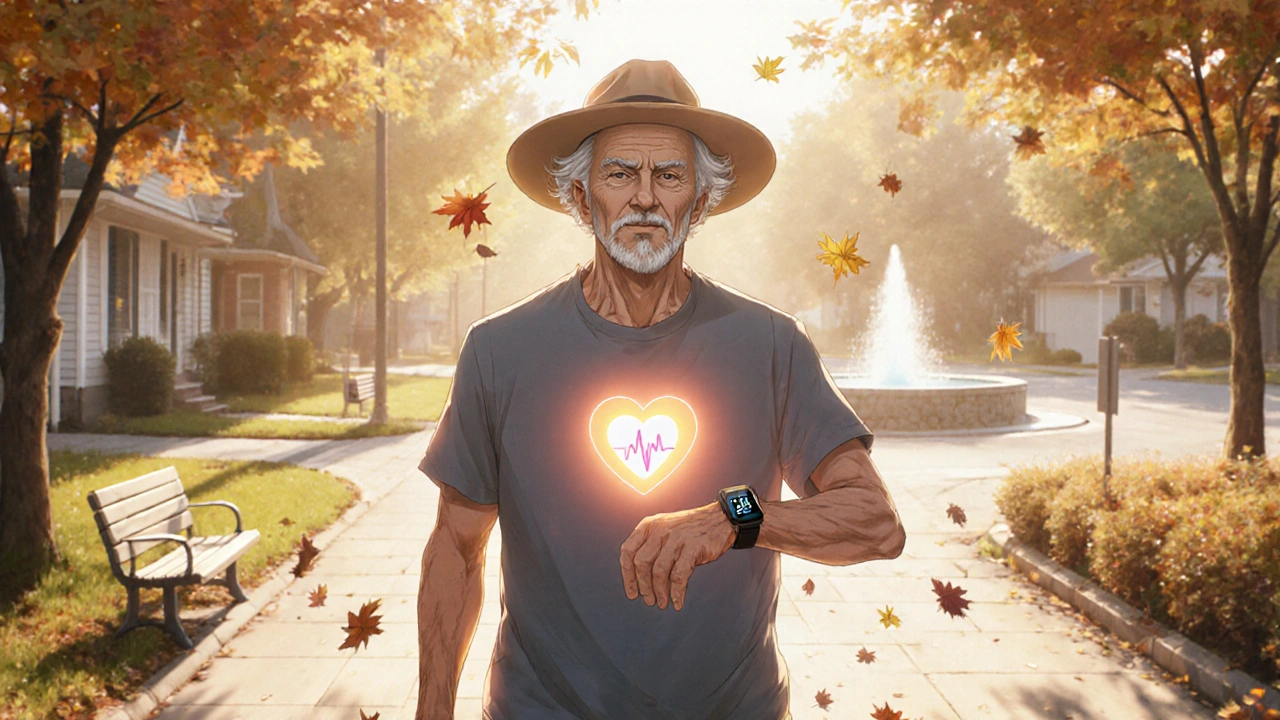When you’re on amiodarone, staying active isn’t just a good idea-it’s often part of your recovery plan. But it’s not as simple as lacing up your sneakers and heading out the door. Amiodarone helps control dangerous heart rhythms, but it also comes with side effects that can make exercise feel risky. You might feel tired faster, notice your heart racing oddly, or get dizzy when you push too hard. The good news? Many people on amiodarone can still walk, swim, cycle, and even lift light weights-safely-if they know what to watch for.
How Amiodarone Affects Your Body During Exercise
Amiodarone works by slowing down abnormal electrical signals in your heart. That’s why it’s used for atrial fibrillation, ventricular tachycardia, and other serious arrhythmias. But it doesn’t just target the bad signals-it can affect your heart’s normal response too. During exercise, your heart naturally beats faster to pump more blood. With amiodarone, that increase might be slower or less predictable. Some people report feeling like their heart is “stuck” or doesn’t respond to effort like it used to.
Another hidden effect? Amiodarone can make your skin and eyes more sensitive to sunlight. If you exercise outdoors, you’re at higher risk for sunburn or even a rare but serious condition called photokeratitis. Thyroid function can also shift on amiodarone-too much or too little thyroid hormone can make you feel sluggish, shaky, or short of breath, all of which impact your ability to work out.
And let’s not forget lung side effects. Though rare, amiodarone can cause inflammation in the lungs. If you suddenly find yourself winded during a walk that used to feel easy, don’t brush it off. It could be a sign something deeper is going on.
What Type of Exercise Is Safe?
Not all exercise is created equal when you’re on amiodarone. High-intensity activities like sprinting, heavy weightlifting, or competitive sports can push your heart beyond its adjusted limits. That’s why most cardiologists recommend sticking to low-to-moderate intensity activities.
- Walking-your best friend. Start with 10-15 minutes a day and build up to 30 minutes. Use a pedometer or phone app to track steps. Aim for 6,000-8,000 steps daily.
- Swimming-gentle on joints and great for cardiovascular health. The water supports your body, reducing strain. Avoid cold pools-cold water can trigger arrhythmias in some people.
- Cycling-on a stationary bike or flat terrain. Keep resistance light and focus on steady rhythm, not speed.
- Light resistance training-use bands or light dumbbells (under 5 lbs). Do 1-2 sets of 12-15 reps. Avoid holding your breath during lifts-that raises pressure in your chest and can stress your heart.
- Yoga and stretching-helps with balance, breathing, and stress. Avoid inverted poses like headstands or shoulder stands, which can affect blood flow to the heart.
Avoid activities like tennis, basketball, or CrossFit until your doctor gives you the green light. These involve sudden bursts of effort and unpredictable movements that can be risky.
How to Monitor Your Body During Workouts
You don’t need a heart monitor to stay safe-but you do need to listen to your body. Here’s what to pay attention to:
- Heart rate-your max safe heart rate on amiodarone isn’t the standard 220 minus your age. Because amiodarone slows your heart, your max might be 10-20 beats lower. If you’re 65, aim for 90-110 bpm during exercise, not 155.
- Shortness of breath-if you can’t speak in full sentences while walking, you’re pushing too hard. Use the “talk test.” If you’re gasping, slow down.
- Dizziness or lightheadedness-stop immediately. This could mean your blood pressure dropped too low or your heart rhythm changed.
- Chest pain or pressure-not normal. Call your doctor or go to the ER. Don’t wait.
- Unusual fatigue-if you’re exhausted for hours after a short walk, your body is signaling overload.
Keep a simple log: date, activity, duration, how you felt, and any symptoms. Bring this to your next cardiology visit. It helps your doctor adjust your meds or exercise plan.

When to Avoid Exercise Altogether
There are times when you should skip your workout-not because you’re weak, but because your body is telling you something urgent.
- You have a fever or infection. Your immune system is already working hard. Adding stress can trigger arrhythmias.
- Your thyroid levels are unstable. If you’re newly diagnosed with amiodarone-induced hypothyroidism or hyperthyroidism, hold off on exercise until your levels are stable.
- You’ve had a recent hospitalization for heart rhythm issues. Wait at least 1-2 weeks after discharge, and only restart with your doctor’s approval.
- You’re feeling unusually anxious, shaky, or sweaty without exertion. These can be signs of thyroid problems or drug toxicity.
- Your skin is blistering after sun exposure. Stop outdoor exercise until you’ve talked to your doctor about sun protection or possible lung involvement.
Medication Timing and Exercise
When you take amiodarone matters. It’s usually taken once daily, often in the morning. But if you take it at night and feel groggy in the morning, that could affect your energy for a workout. Talk to your doctor about whether switching to an afternoon dose might help you feel more alert during the day.
Also, avoid taking amiodarone right before exercise. Some people report increased dizziness or low blood pressure when the drug peaks in their system. Taking it after your workout-say, after your evening walk-might reduce side effects.
Don’t skip doses, even if you feel tired. Missing doses can cause your arrhythmia to come back, which is far riskier than any workout.

What to Tell Your Doctor
Many people don’t mention their exercise habits to their cardiologist because they’re afraid they’ll be told to stop. But your doctor needs to know what you’re doing to help you stay safe.
At your next visit, say:
- “I’ve been walking 20 minutes a day, five days a week. I feel better, but I get winded faster than before.”
- “I noticed my heart feels irregular after swimming. Is that normal?”
- “I’ve been feeling more tired lately. Could it be my thyroid?”
Your doctor might order blood tests to check your thyroid, liver, and lung function. They might also recommend a stress test to see how your heart responds to physical effort under controlled conditions.
Real-Life Example: Margaret’s Story
Margaret, 72, from Adelaide, was diagnosed with atrial fibrillation in early 2024. Her doctor prescribed amiodarone. At first, she stopped all activity because she was scared. Within three months, she gained 12 pounds and felt more anxious.
Her cardiologist suggested starting with 10-minute walks around her neighborhood. She used a simple heart rate monitor on her wrist. After two weeks, she added light resistance bands. By month four, she was walking 30 minutes daily and doing yoga twice a week. She didn’t push herself. She didn’t try to match her old fitness level. She just showed up.
“I didn’t get back to being fit,” she says. “I got back to being alive.”
Final Tips for Staying Active on Amiodarone
- Start slow. Even 5 minutes a day counts.
- Hydrate well. Amiodarone can affect kidney function, and dehydration increases arrhythmia risk.
- Wear sunscreen and a hat. Even on cloudy days.
- Exercise with a friend or in a group. If you feel unwell, someone can help.
- Keep your emergency contact and doctor’s number in your phone. Add a medical ID bracelet if you’re at risk for fainting.
- Don’t compare yourself to others. Your heart is healing differently than theirs.
Amiodarone isn’t a life sentence to sitting still. It’s a tool to help your heart beat steady so you can keep moving. Listen to your body. Track your progress. Talk to your care team. And remember-you’re not trying to be the fastest or strongest. You’re trying to be safe, steady, and strong enough to enjoy your days.
Can I still lift weights while on amiodarone?
Yes, but only light weights-under 5 pounds-and with controlled breathing. Avoid heavy lifting, straining, or holding your breath. Focus on higher reps (12-15) with low resistance. Always check with your cardiologist first, especially if you’ve had recent heart issues.
Does amiodarone make you tired all the time?
Fatigue is common, but not inevitable. It can come from the drug itself, low thyroid levels, or simply being out of shape after a heart rhythm problem. Get your thyroid checked. If levels are normal, start with short walks. Often, energy improves within 4-6 weeks of gentle, consistent activity.
Is it safe to exercise outdoors on amiodarone?
Yes, but protect your skin. Amiodarone makes you extremely sensitive to UV light. Use broad-spectrum SPF 50+, wear a wide-brimmed hat, and avoid midday sun. If your skin turns red or blisters easily after minimal exposure, tell your doctor-it could signal lung or thyroid issues.
How long should I wait to exercise after starting amiodarone?
There’s no set waiting period. If you’re stable and not dizzy or short of breath, start with light walking within a week. If you were recently hospitalized or had a serious arrhythmia, wait 1-2 weeks and get clearance from your doctor. Always start slower than you think you should.
Can amiodarone cause heart rhythm problems during exercise?
It’s possible, but rare. Amiodarone is meant to prevent arrhythmias. However, if you’re overmedicated, dehydrated, or have low potassium or magnesium, it can sometimes cause new rhythm issues. That’s why blood tests and listening to your body are critical. If your heart skips, races, or pounds during activity, stop and rest. If it doesn’t settle, seek help.









Jim Oliver
Amiodarone isn't a walk in the park. If you're lifting weights, you're either lying or dead. Under 5 lbs? That's not lifting. That's waving a feather. And don't even get me started on yoga-headstands are a death sentence waiting to happen.
William Priest
lol so amiodarone makes you sensitive to sun? i thought it was just me being a pale ghost who melts in july. also i did 20 min walk yesterday and my heart felt like it was trying to escape. weird. but hey, at least i didn't die.
Ryan Masuga
You got this. Even 5 minutes of walking counts. I started with just pacing my living room-felt silly at first, but now I’m up to 25 minutes. No fancy gear, no goals, just showing up. Your body remembers how to move, even when your brain is scared. Keep going.
Jennifer Bedrosian
I tried swimming last week and my skin turned red like I’d been grilled and I cried for an hour because I thought I was dying but it was just the sun and amiodarone and now i’m scared to leave the house and also my cat judges me
Lashonda Rene
I know it feels like your body is betraying you but honestly i think the most important thing is just being gentle with yourself. I used to run marathons and now i can barely walk to the mailbox without getting winded but i’m not mad about it anymore. It’s not about being strong like before. It’s about being alive today. And that’s enough. Really. It is.
Andy Slack
Started walking 10 mins a day. Two weeks later: 22 mins. No fancy stats. Just me, my shoes, and the birds. You don’t need to be fast. You just need to keep moving. One step. Then another. That’s the win.
Rashmi Mohapatra
Why are you even exercising? You should just rest. India has people who live to 100 without touching a treadmill. You don't need to prove anything. Just sit. Eat dal. Be calm. Your heart will thank you.
Kelsey Veg
The article says 'light weights under 5 lbs' but doesn't mention that amiodarone can cause pulmonary fibrosis in 1-2% of cases. If you're coughing even slightly after walking, you're already in the danger zone. You're not 'being safe'-you're gambling with your lungs.
Alex Harrison
I’ve been on this med for 3 years. Walking every morning. Took me 6 months to get to 20 mins. Still get dizzy sometimes. But I don’t skip. My doc says my numbers are better than when I was 30. Not perfect. But better. That’s all I need.
Jay Wallace
Americans think they can out-exercise every pill. In my country, we don’t need to walk 8,000 steps to survive. We eat, we rest, we pray. You’re not a machine. Stop trying to optimize your heart like it’s a Tesla battery.
Alyssa Fisher
There’s a quiet dignity in moving slowly when your body won’t let you move fast. It’s not failure-it’s recalibration. The heart doesn’t care about miles or reps. It cares about rhythm. And rhythm doesn’t need speed. Just presence.
Alyssa Salazar
The article mentions thyroid dysfunction but doesn't emphasize that amiodarone-induced thyrotoxicosis can be life-threatening if not caught early. You need TSH, FT4, and anti-TPO levels checked every 3 months-not just 'if you feel off.' If you're not getting this from your doc, fire them. This isn't a suggestion. It's a clinical imperative.